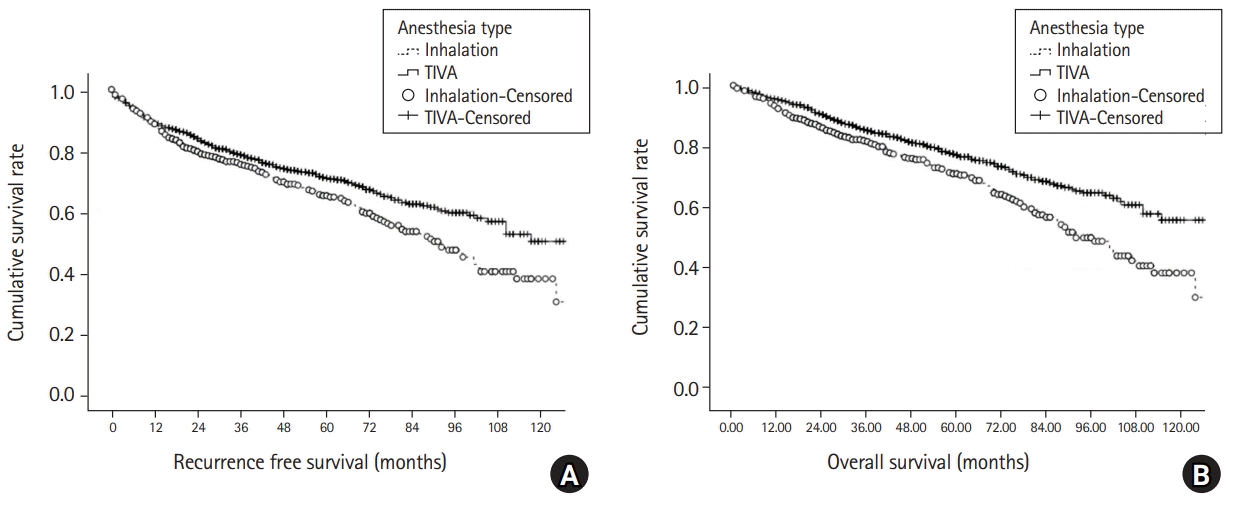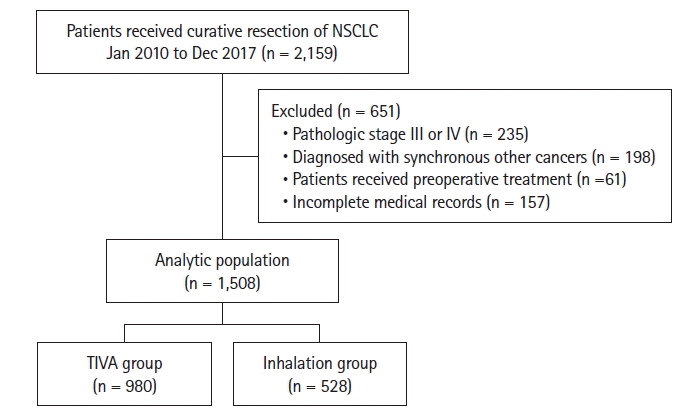1. Dubowitz JA, Sloan EK, Riedel BJ. Implicating anaesthesia and the perioperative period in cancer recurrence and metastasis. Clin Exp Metastasis. 2018; 35:347–58.
2. Tohme S, Simmons RL, Tsung A. Surgery for cancer: a trigger for metastases. Cancer Res. 2017; 77:1548–52.
3. Chang CY, Wu MY, Chien YJ, Su IM, Wang SC, Kao MC. Anesthesia and long-term oncological outcomes: a systematic review and meta-analysis. Anesth Analg. 2021; 132:623–34.
4. Parab S, Gaikwad S, Majeti S. Inhalational versus intravenous anesthetics during one lung ventilation in elective thoracic surgeries: a narrative review. Saudi J Anaesth. 2021; 15:312–23.
5. Yap A, Lopez-Olivo MA, Dubowitz J, Hiller J, Riedel B; Global Onco-Anesthesia Research Collaboration Group. Anesthetic technique and cancer outcomes: a meta-analysis of total intravenous versus volatile anesthesia. Can J Anaesth. 2019; 66:546–61.
6. Wigmore TJ, Mohammed K, Jhanji S. Long-term survival for patients undergoing volatile versus IV anesthesia for cancer surgery: a retrospective analysis. Anesthesiology. 2016; 124:69–79.
7. Xu Y, Pan S, Jiang W, Xue F, Zhu X. Effects of propofol on the development of cancer in humans. Cell Prolif. 2020; 53:e12867.
8. Jun IJ, Jo JY, Kim JI, Chin JH, Kim WJ, Kim HR, et al. Impact of anesthetic agents on overall and recurrence-free survival in patients undergoing esophageal cancer surgery: a retrospective observational study. Sci Rep. 2017; 7:14020.
9. Lai HC, Lee MS, Lin KT, Huang YH, Chen JY, Lin YT, et al. Propofol-based total intravenous anesthesia is associated with better survival than desflurane anesthesia in robot-assisted radical prostatectomy. PLoS One. 2020; 15:e0230290.
10. Wu ZF, Lee MS, Wong CS, Lu CH, Huang YS, Lin KT, et al. Propofol-based total intravenous anesthesia is associated with better survival than desflurane anesthesia in colon cancer surgery. Anesthesiology. 2018; 129:932–41.
11. Gao X, Mi Y, Guo N, Luan J, Xu H, Hu Z, et al. The mechanism of propofol in cancer development: an updated review. Asia Pac J Clin Oncol. 2020; 16:e3–11.
12. Jiang S, Liu Y, Huang L, Zhang F, Kang R. Effects of propofol on cancer development and chemotherapy: potential mechanisms. Eur J Pharmacol. 2018; 831:46–51.
13. Ciechanowicz S, Zhao H, Chen Q, Cui J, Mi E, Mi E, et al. Differential effects of sevoflurane on the metastatic potential and chemosensitivity of non-small-cell lung adenocarcinoma and renal cell carcinoma in vitro. Br J Anaesth. 2018; 120:368–75.
14. Quan Y, Li S, Wang Y, Liu G, Lv Z, Wang Z. Propofol and sevoflurane alleviate malignant biological behavior and cisplatin resistance of Xuanwei lung adenocarcinoma by modulating the Wnt/β-catenin pathway and PI3K/AKT pathway. Anticancer Agents Med Chem. 2022; 22:2098–108.
15. Zhang W, Shao X. Isoflurane promotes non-small cell lung cancer malignancy by activating the Akt-mammalian target of rapamycin (mTOR) signaling pathway. Med Sci Monit. 2016; 22:4644–50.
16. Bray F, Ferlay J, Soerjomataram I, Siegel RL, Torre LA, Jemal A. Global cancer statistics 2018: GLOBOCAN estimates of incidence and mortality worldwide for 36 cancers in 185 countries. CA Cancer J Clin. 2018; 68:394–424.
18. de La Motte Watson S, Puxty K, Moran D, Morrison DS, Sloan B, Buggy D, et al. Association between anesthetic dose and technique and oncologic outcomes after surgical resection of non-small cell lung cancer. J Cardiothorac Vasc Anesth. 2021; 35:3265–74.
19. Hayasaka K, Shiono S, Miyata S, Takaoka S, Endoh M, Okada Y. Prognostic significance of propofol-based intravenous anesthesia in early-stage lung cancer surgery. Surg Today. 2021; 51:1300–8.
20. Oh TK, Kim K, Jheon S, Lee J, Do SH, Hwang JW, et al. Long-term oncologic outcomes for patients undergoing volatile versus intravenous anesthesia for non-small cell lung cancer surgery: a retrospective propensity matching analysis. Cancer Control. 2018; 25:1073274818775360.
21. Enlund M, Berglund A, Enlund A, Bergkvist L. Volatile versus propofol general anesthesia and long-term survival after breast cancer surgery: a national registry retrospective cohort study. Anesthesiology. 2022; 137:315–26.
22. Lee S, Cho JS, Kim E, Kim Y, Lee J. Effects of inhalation versus total intravenous anesthesia on postoperative pulmonary complications after anatomic pulmonary resection. J Chest Surg. 2022; 55:30–6.
23. Jin Y, Zhao X, Li H, Wang Z, Wang D. Effects of sevoflurane and propofol on the inflammatory response and pulmonary function of perioperative patients with one-lung ventilation. Exp Ther Med. 2013; 6:781–5.
24. Xing SG, Zhang KJ, Qu JH, Ren YD, Luan Q. Propofol induces apoptosis of non-small cell lung cancer cells via ERK1/2-dependent upregulation of PUMA. Eur Rev Med Pharmacol Sci. 2018; 22:4341–9.
25. Yang N, Liang Y, Yang P, Ji F. Propofol suppresses LPS-induced nuclear accumulation of HIF-1α and tumor aggressiveness in non-small cell lung cancer. Oncol Rep. 2017; 37:2611–9.
26. Liu WZ, Liu N. Propofol inhibits lung cancer A549 cell growth and epithelial-mesenchymal transition process by upregulation of microRNA-1284. Oncol Res. 2018; 27:1–8.
27. Sun H, Gao D. Propofol suppresses growth, migration and invasion of A549 cells by down-regulation of miR-372. BMC Cancer. 2018; 18:1252.
28. Kim Y, Yun S, Shin KA, Chung W, Ko Y, Kim YH, et al. Effects of sevoflurane on Lewis lung carcinoma cell proliferation in vivo and in vitro. Medicina (Kaunas). 2021; 57:45.
29. Su G, Yan Z, Deng M. Sevoflurane inhibits proliferation, invasion, but enhances apoptosis of lung cancer cells by Wnt/β-catenin signaling via regulating lncRNA PCAT6/miR-326 axis. Open Life Sci. 2020; 15:159–72.
30. Sen Y, Xiyang H, Yu H. Effect of thoracic paraspinal block-propofol intravenous general anesthesia on VEGF and TGF-β in patients receiving radical resection of lung cancer. Medicine (Baltimore). 2019; 98:e18088.
31. Churchhouse AM, Mathews TJ, McBride OM, Dunning J. Does blood transfusion increase the chance of recurrence in patients undergoing surgery for lung cancer? Interact Cardiovasc Thorac Surg. 2012; 14:85–90.
32. Heaney A, Buggy DJ. Can anaesthetic and analgesic techniques affect cancer recurrence or metastasis? Br J Anaesth. 2012; 109 Suppl 1:i17–28.
33. Makito K, Matsui H, Fushimi K, Yasunaga H. Volatile versus total intravenous anesthesia for cancer prognosis in patients having digestive cancer surgery. Anesthesiology. 2020; 133:764–73.
34. Beck-Schimmer B, Bonvini JM, Braun J, Seeberger M, Neff TA, Risch TJ, et al. Which anesthesia regimen is best to reduce morbidity and mortality in lung surgery?: a multicenter randomized controlled trial. Anesthesiology. 2016; 125:313–21.
35. Oh TK, Jeon JH, Lee JM, Kim MS, Kim JH, Cho H, et al. Investigation of opioid use and long-term oncologic outcomes for non-small cell lung cancer patients treated with surgery. PLoS One. 2017; 12:e0181672.





 PDF
PDF Citation
Citation Print
Print




 XML Download
XML Download